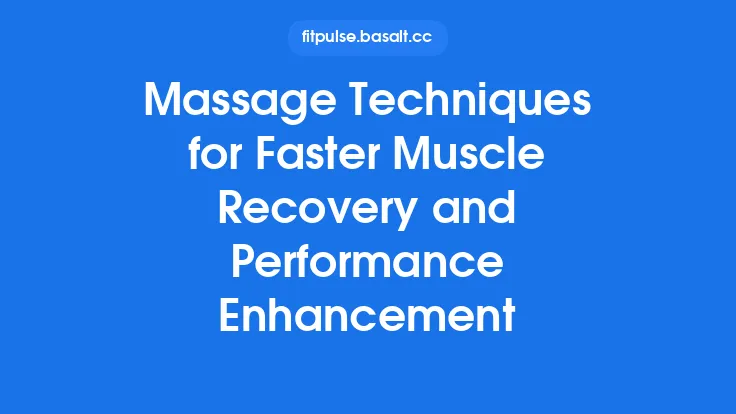Recovery is the often‑overlooked half of any successful aerobic training program. While the miles logged, intervals completed, and heart‑rate zones conquered receive most of the attention, the quality of the recovery that follows determines whether those training stresses translate into lasting performance gains. By systematically addressing the physiological, biochemical, and psychological components of recovery, athletes can accelerate adaptations, reduce injury risk, and sustain high‑quality work across weeks, months, and even years of training.
Why Recovery Is Critical for Aerobic Performance
Aerobic training imposes repeated metabolic and mechanical stress on the cardiovascular, respiratory, and musculoskeletal systems. After a hard session, several processes must occur before the body is ready to train again at the same intensity:
| Process | Primary Effect on Performance |
|---|---|
| Glycogen Re‑synthesis | Restores the primary fuel for prolonged effort; incomplete replenishment limits subsequent training volume. |
| Mitochondrial Repair & Biogenesis | Damaged mitochondrial proteins are replaced, and new mitochondria are formed, enhancing oxidative capacity. |
| Cardiac Remodeling | Stroke volume and capillary density improve during recovery, supporting higher cardiac output. |
| Inflammatory Resolution | Cytokine spikes subside, preventing chronic low‑grade inflammation that can blunt adaptations. |
| Neuromuscular Reset | Motor unit firing patterns normalize, preserving running economy and stride efficiency. |
When any of these processes are truncated—by insufficient sleep, inadequate nutrition, or excessive training frequency—the athlete experiences “training fatigue,” manifested as slower paces, elevated perceived exertion, and a higher risk of overuse injuries.
Active Recovery Strategies
Active recovery involves low‑intensity movement performed shortly after a hard aerobic session. The goal is to promote blood flow without adding significant metabolic stress.
- Low‑Intensity Aerobic Cool‑Down (5–15 min)
- Intensity: 30–50 % of VO₂max (e.g., easy jog, brisk walk, or light cycling).
- Physiological Rationale: Enhances venous return, accelerates lactate clearance via oxidation, and facilitates the removal of metabolic by‑products such as hydrogen ions.
- Dynamic Stretching & Mobility Drills
- Examples: Leg swings, hip circles, ankle pumps.
- Benefit: Restores range of motion lost during high‑intensity work, reduces muscle stiffness, and prepares joints for the next training day.
- Foam Rolling & Myofascial Release (2–3 min per major muscle group)
- Mechanism: Mechanical pressure helps reorganize collagen fibers, improves tissue pliability, and may modulate local inflammatory responses.
- Contrast Water Therapy (CWT)
- Protocol: Alternate 1 min of cold water immersion (10–15 °C) with 1 min of warm water (38–40 °C) for 3–5 cycles.
- Effect: Induces vasoconstriction followed by vasodilation, creating a “pumping” effect that enhances lymphatic drainage and reduces delayed‑onset muscle soreness (DOMS).
- Low‑Intensity Aerobic Cross‑Training
- When to Use: On days following a particularly taxing long run or interval session.
- Options: Swimming, rowing, or elliptical work at a conversational pace.
- Why It Helps: Provides cardiovascular stimulus while off‑loading impact stress on the lower limbs.
Passive Recovery Modalities
Passive recovery allows the body to rest completely, relying on internal repair mechanisms. These methods are especially valuable after ultra‑endurance events or when training load spikes.
- Complete Rest Days
- Frequency: Typically 1–2 per week for most endurance athletes, adjusted based on training intensity and individual recovery capacity.
- Purpose: Enables full glycogen restoration, hormonal balance (e.g., cortisol reduction), and central nervous system recovery.
- Sleep Optimization
- Quantity: 7–10 hours per night for most adults; elite endurance athletes often benefit from the upper end of this range.
- Quality Enhancers: Dark, cool bedroom; consistent bedtime; limited screen exposure; and, if needed, short daytime naps (20–30 min) to supplement nighttime sleep.
- Compression Garments
- Application: Wear graduated compression tights or sleeves for 2–4 hours post‑exercise.
- Physiological Impact: Improves venous return, reduces interstitial fluid accumulation, and may attenuate muscle swelling.
- Cold Water Immersion (CWI)
- Protocol: Submerge up to the waist in 10–12 °C water for 10–15 minutes.
- Outcome: Lowers muscle temperature, reduces metabolic rate, and blunts the acute inflammatory response, which can be useful when rapid recovery is required (e.g., back‑to‑back race days).
- Massage Therapy
- Technique: Light to moderate pressure focusing on large muscle groups used during aerobic training.
- Benefit: Increases local blood flow, promotes relaxation, and can improve subjective recovery scores.
Sleep: The Cornerstone of Aerobic Recovery
While many athletes prioritize post‑exercise nutrition or ice baths, sleep remains the most potent recovery tool. During deep (slow‑wave) sleep, growth hormone secretion peaks, stimulating protein synthesis and glycogen storage. REM sleep, on the other hand, supports neural plasticity and emotional regulation—both essential for maintaining motivation and focus during long training blocks.
Practical Tips for Enhancing Sleep Quality
| Tip | Implementation |
|---|---|
| Consistent Sleep‑Wake Schedule | Go to bed and rise at the same times daily, even on weekends. |
| Pre‑Sleep Routine | Engage in a calming activity (e.g., reading, gentle yoga) 30–60 min before lights out. |
| Environmental Control | Keep the bedroom temperature around 18–20 °C; use blackout curtains or a sleep mask. |
| Limit Stimulants | Avoid caffeine after 2 p.m. and limit alcohol, which disrupts REM cycles. |
| Screen Management | Use blue‑light filters or switch off devices at least 1 hour before bedtime. |
Nutrition and Hydration Tailored for Recovery
Although broader nutrition strategies fall under a separate article, specific recovery‑focused guidelines are essential for optimizing aerobic performance.
- Post‑Exercise Carbohydrate‑Protein Ratio
- Guideline: 3:1 or 4:1 carbohydrate to protein (e.g., 60 g carbs + 15 g protein) within 30 minutes of finishing a session.
- Rationale: Carbohydrates replenish glycogen, while protein supplies amino acids for mitochondrial repair and muscle protein synthesis.
- Electrolyte Repletion
- Key Ions: Sodium, potassium, magnesium, and calcium.
- Sources: Sports drinks, coconut water, or a balanced meal containing fruits, vegetables, and dairy.
- Omega‑3 Fatty Acids
- Dose: 1–2 g EPA/DHA per day.
- Benefit: Anti‑inflammatory properties may reduce DOMS and support cardiovascular health.
- Antioxidant Timing
- Approach: Consume antioxidant‑rich foods (berries, leafy greens) in the evening rather than immediately post‑exercise to avoid blunting the oxidative signaling needed for mitochondrial adaptations.
- Hydration Monitoring
- Method: Weigh yourself before and after training; aim for ≤ 2 % body‑weight loss. Replace fluids with a mix of water and electrolytes to restore plasma volume.
Periodization of Recovery
Just as training intensity is periodized, recovery should be deliberately programmed.
- Macrocycle Planning: Allocate “recovery weeks” (often every 4–6 weeks) where training volume is reduced by 20–30 % and intensity is moderated.
- Microcycle Structure: Within a typical week, schedule at least one full rest day and one active‑recovery day.
- Tapering Before Key Races: Gradually decrease training load over 7–14 days while maintaining intensity to preserve aerobic fitness and maximize super‑compensation.
By embedding recovery into the periodization model, athletes avoid the “training‑recovery mismatch” that leads to chronic fatigue.
Monitoring Recovery: Objective and Subjective Tools
Effective recovery strategies require feedback. Combining objective metrics with subjective assessments provides a comprehensive picture.
| Tool | What It Measures | Practical Use |
|---|---|---|
| Heart‑Rate Variability (HRV) | Autonomic balance (parasympathetic vs. sympathetic activity). | Lower HRV may signal insufficient recovery; adjust upcoming training load accordingly. |
| Resting Heart Rate (RHR) | General cardiovascular stress. | A rise of > 5 bpm from baseline can indicate accumulated fatigue. |
| Morning Questionnaires (e.g., Rate of Perceived Recovery, Muscle Soreness, Mood) | Subjective readiness. | Quick daily check to flag potential overreaching. |
| Sleep Tracking (actigraphy or wearable) | Duration and quality of sleep stages. | Identify sleep deficits that may impair recovery. |
| Blood Biomarkers (optional) – Creatine kinase, cortisol, testosterone ratios. | Tissue damage and hormonal status. | Useful for elite athletes during high‑stress periods. |
Consistent logging of these variables enables data‑driven adjustments, ensuring that recovery interventions are neither under‑ nor over‑applied.
Common Pitfalls in Recovery Practices
- Over‑Reliance on Passive Modalities
- Solely resting without any low‑intensity movement can lead to stiffness and slower lactate clearance.
- Excessive Use of Cold Therapies
- Chronic cold immersion may blunt mitochondrial adaptations if applied after every hard session. Reserve it for races or particularly taxing weeks.
- Neglecting Psychological Recovery
- Mental fatigue can manifest as physical fatigue. Incorporate relaxation techniques (e.g., meditation, breathing exercises) to support overall recovery.
- Inconsistent Sleep Patterns
- Even occasional late nights can disrupt circadian rhythms, impairing hormonal recovery pathways.
- Ignoring Individual Variability
- Recovery needs differ by age, training history, and genetics. Personalize protocols rather than applying a one‑size‑fits‑all approach.
Integrating Recovery Into Your Training Routine
A practical framework for embedding recovery into a weekly aerobic program:
| Day | Session | Recovery Action |
|---|---|---|
| Mon | Long steady‑state run (90 min) | 10‑min cool‑down jog + foam rolling; hydrate; 30 g carbs + 10 g protein within 30 min. |
| Tue | Easy bike (45 min) | Light dynamic stretching; optional CWT post‑ride. |
| Wed | Interval session (HIIT) | 15‑min active cool‑down; compression tights for 2 h; protein‑rich meal; early bedtime. |
| Thu | Rest day | Full sleep extension (≥ 9 h); mindfulness meditation (10 min). |
| Fri | Tempo run (60 min) | Post‑run massage; CWI (10 min) if race‑week; electrolyte‑rich snack. |
| Sat | Cross‑training (swim) | Low‑intensity swim; gentle yoga; hydration focus. |
| Sun | Recovery jog (30 min) + mobility | Foam rolling; HRV check; plan next week’s load. |
Adjust the specifics based on training phase, competition schedule, and personal response.
Bottom Line
Recovery is not a passive afterthought; it is an active, science‑backed component of aerobic conditioning that determines whether training stress translates into lasting performance improvements. By combining active and passive recovery modalities, prioritizing sleep, fine‑tuning nutrition for post‑exercise repair, periodizing rest, and continuously monitoring both objective and subjective markers, athletes can enhance mitochondrial efficiency, preserve glycogen stores, and maintain cardiovascular health—all essential ingredients for superior aerobic performance. Implement these evidence‑based strategies consistently, and the gains on the track, trail, or road will follow naturally.





